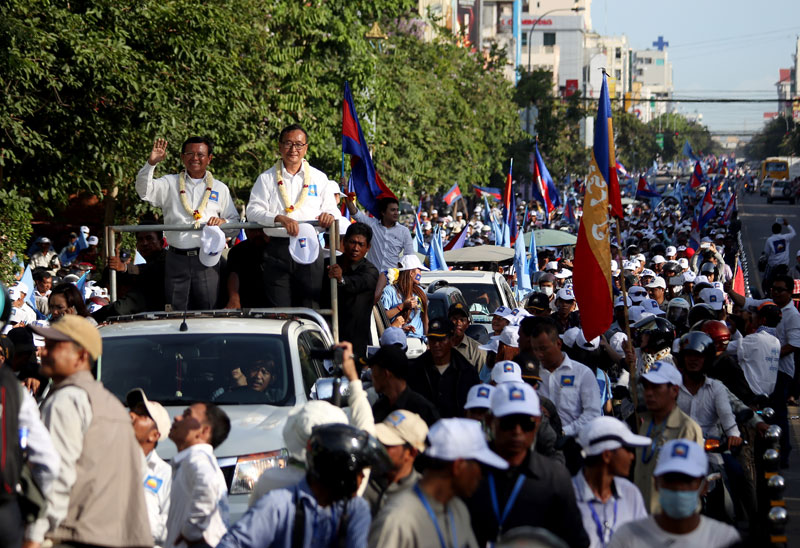The opposition CNRP used the final day of the council election campaign Friday to stage the largest political rally of the year, with up to 15,000 people marching from the southern limits of Phnom Penh to Wat Phnom in the north.
The rally—fronted by opposition leaders Sam Rainsy and Kem Sokha—passed with no violence, but the CNRP could face legal action after departing from a City Hall-approved route and marching to the fringes of the off-limits Freedom Park, where party supporters tossed aside a police barricade.

“They broke the law because they told us they would not go to Wat Phnom or Freedom Park,” said City Hall spokesman Long Dimanche. “[Deputy municipal governor] Khuong Sreng has already signed a letter to send to the [Phnom Penh Election Committee] about the CNRP disrespecting the agreements we made at a meeting last week.”
The CNRP had publicized an approved route that would turn left off Monivong Boulevard onto Kampuchea Krom Boulevard. But as the thousands moved north along the major thoroughfare, plans changed and the procession turned right toward Freedom Park, which had been declared a campaign-free zone by the National Election Committee.
After the rally, Mr. Rainsy said by telephone that the decision to march on the heavily secured Freedom Park was spontaneous and that supporters had demanded it. He said with such a large crowd in tow, it was the perfect opportunity to demonstrate the CNRP’s force.
“We wanted to tell [the government] that, had we wanted, we could have encircled them and taken Freedom Park,” Mr. Rainsy said.
“The soldiers would have become prisoners in Freedom Park. How would a couple of hundred soldiers respond if we actually attempted to take Freedom Park?” he asked, estimating the size of the rally at nearly 100,000 people.
Around 5 p.m., as the front end of the rerouted march rounded the southern edge of Wat Phnom, about two dozen Daun Penh district security guards stood by in the park, some helmeted and practicing their baton swings, others looking less than enthusiastic about a clash.
Some opposition supporters stopped to goad the men, who have in recent months been employed by City Hall to violently disperse opposition and labor protests.
Rally organizers then ushered the march onto Norodom Boulevard toward Freedom Park, where a traffic police barricade was set up, with armored trucks and riot police holding gas canisters 50 meters further down the road at the entrance to Naga Bridge.
As the crowd tossed aside the light barricades, one officer commanding the riot police could be heard shouting, “Beat them to death, beat them to death!”
Real Camerin, a CNRP lawmaker-elect from Svay Rieng province, stepped out of the crowd and marched toward a void between the police line and the demonstration, where a riot police commander met him.
The pair had a heated discussion before the march was again rerouted east away from Freedom Park.
“I don’t know what these people want,” Mr. Camerin said of the government forces afterward. “We are just marching, but they come to try and scare us.”
The march then crawled south along Street 19 before rejoining the original route along Kampuchea Krom Boulevard, where Mr. Rainsy mounted a truck and berated the ruling CPP.
“They make the country poor. The youth have no jobs—300,000 to 400,000 students leave school every year and then kick the air, while the children of the rich have everything,” he said.
“If the CPP leads, there are no jobs. The leader of our society cannot modernize the country, he only gives away sarongs.”
Mr. Dimanche, the City Hall spokesman, said that the CNRP deserved to face action from the NEC for the march and for “injuring” police barricades near Wat Phnom.
“They did more than campaign, they incited people to hate,” Mr. Dimanche said.
Mr. Rainsy, however, said that the CNRP has simply used the election campaign period to demonstrate to the country’s 11,459 commune councilors—more than 8,000 of them CPP—that the tide had turned in favor of the opposition ahead of Sunday’s vote.
“We want the voters to know that the people who elected them have switched to the CNRP and if they want to switch as well, the people are on their side,” he said.



